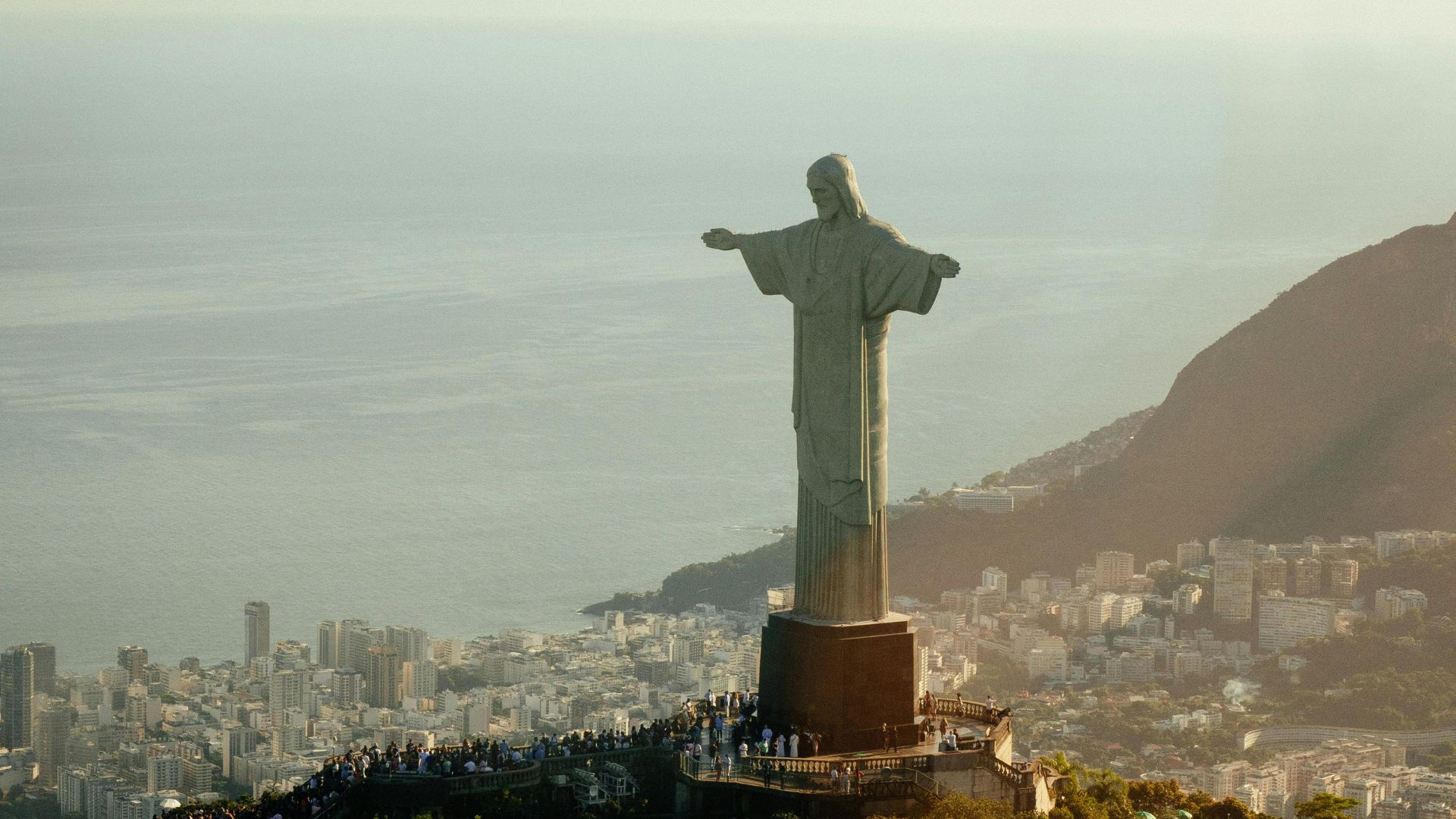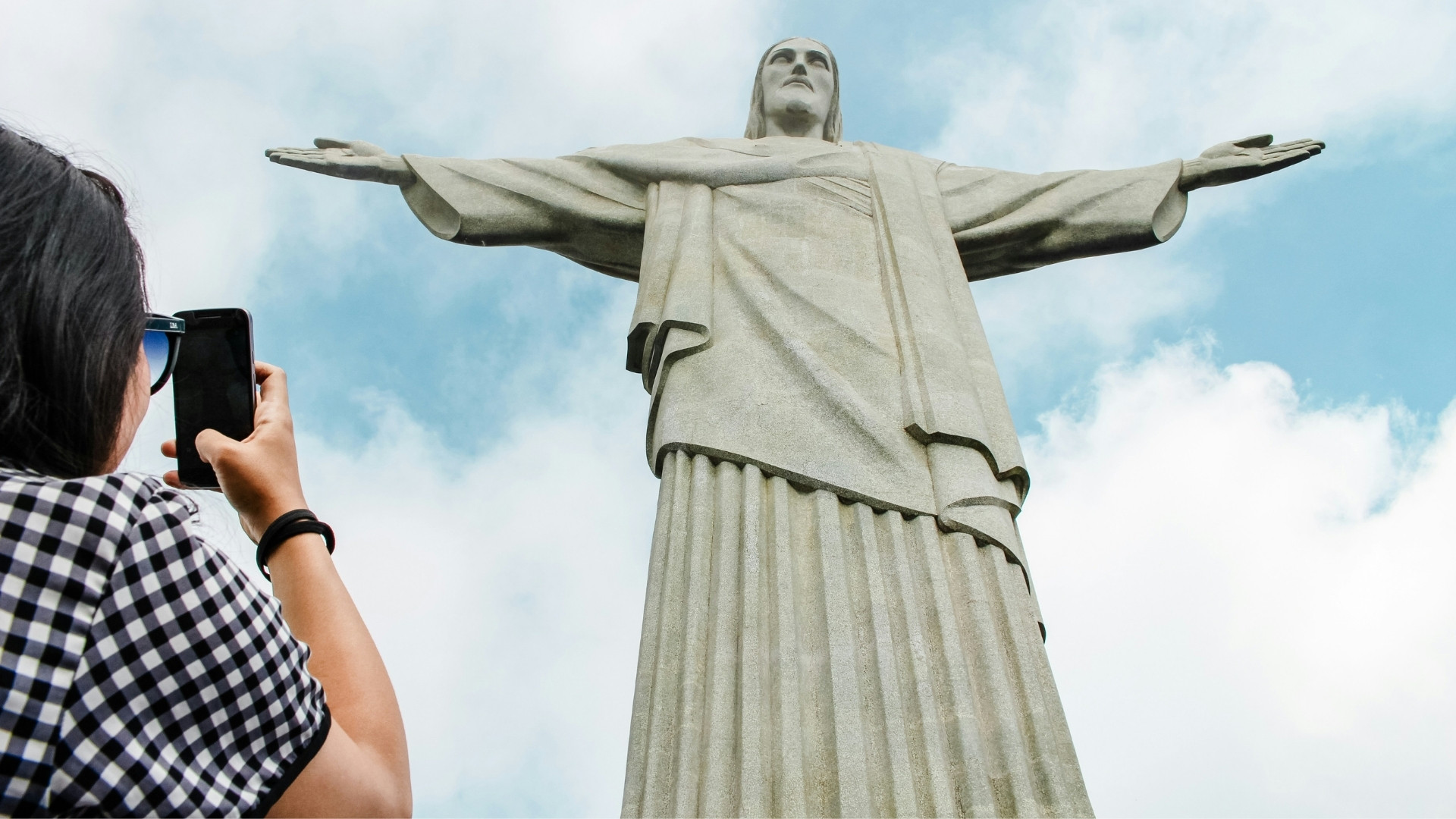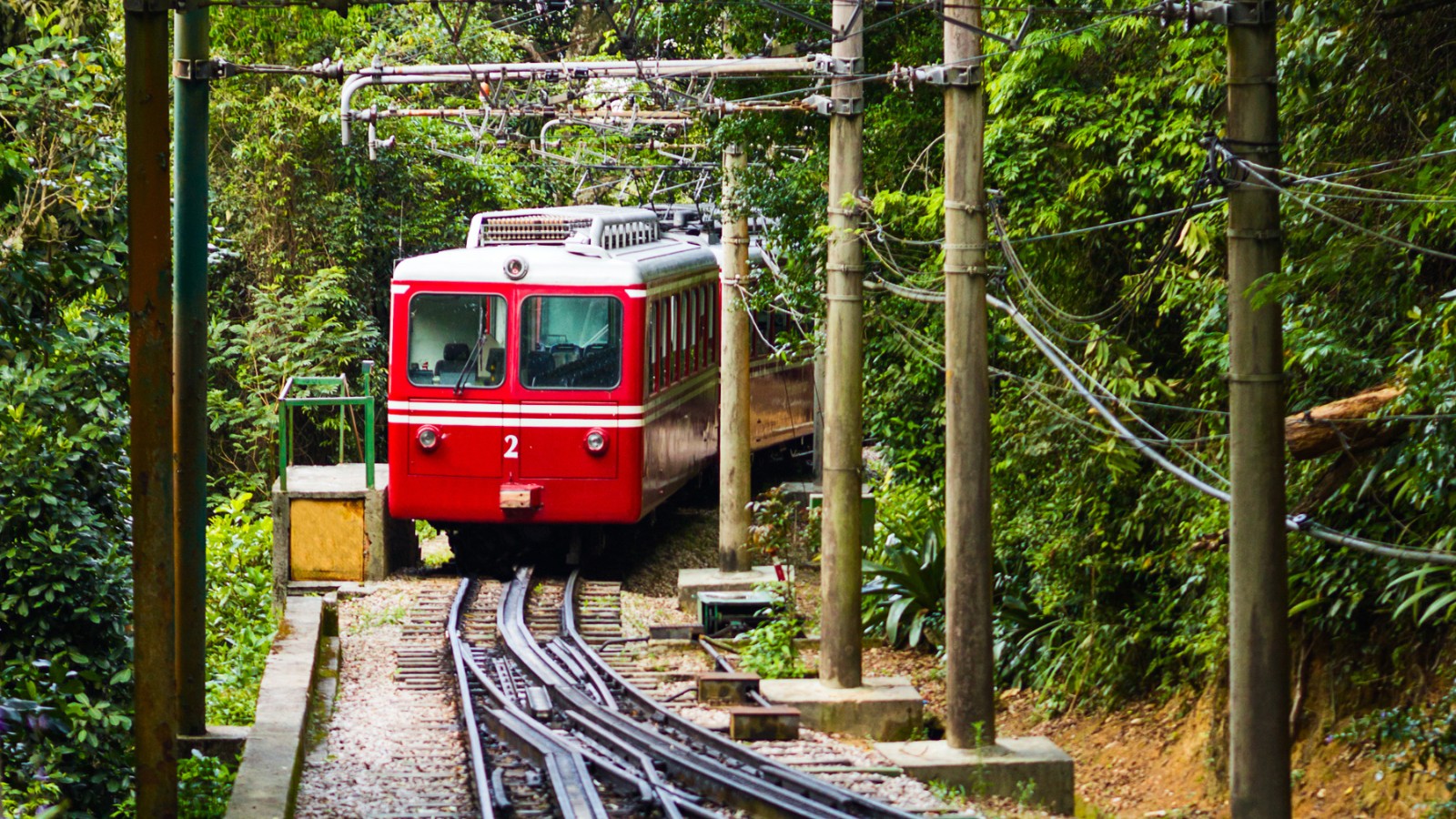Perched 710 meters above Rio de Janeiro, Christ the Redeemer stands as one of the New Seven Wonders of the World and quite possibly South America’s most photographed monument. Nearly two million people make the pilgrimage each year to stand beneath those outstretched arms.
Christ the Redeemer Tickets
Rio tickets sell out quickly. We recommend booking your tickets online as early as possible. Here’s a brief overview of the different ticket options:
Entry Ticket by Corcovado Train (bestseller): Experience a scenic train journey through Tijuca Forest to Brazil’s most iconic landmark. Marvel at panoramic views of Rio from the base of this Modern World Wonder.
6-Stop Highlights Tour with Lunch (#1 rated day trip): The complete Rio experience with visits to all major attractions including Maracanã Stadium and Sambadrome. Includes a delicious Brazilian buffet lunch and expert multilingual guides.
Christ the Redeemer, Selarón Steps & Sugarloaf Sunset: Enjoy the magical sunset from Sugarloaf Mountain after visiting Christ the Redeemer and the colorful Selarón Steps. This 6-hour tour includes hotel transportation and a professional guide.
(All tickets include access to Christ the Redeemer)
We recommend booking through GetYourGuide or Tiqets to increase your chances of finding a ticket for your preferred dates.
Highlights

- Stand beneath the world’s largest Art Deco sculpture with arms spanning 28 meters wide
- Experience 360-degree views over Rio’s most famous landmarks
- Journey through Tijuca National Park aboard the historic Corcovado Train
Tickets & Tours
Getting to Christ the Redeemer requires planning. You can’t just drive to the top and walk up. All visitors must use official transportation and purchase tickets that include both transport and monument access.
Corcovado Train
The Corcovado Train remains the most popular route. Operating since 1884, this historic railway climbs through Atlantic rainforest for 20 minutes each way. Tickets include the round-trip journey and entrance to the statue.
Adults pay around R$93.50 (roughly $18 USD), children aged 5-11 pay R$64, and Brazilian seniors get reduced rates at R$32. The train departs from Cosme Velho station every 20-30 minutes starting at 7:20 AM, with the last departure around 7 PM.
Van Transportation
Official vans offer another option, departing from Praça do Lido in Copacabana, Largo do Machado, or the Paineiras Visitor Center. Van tickets include summit entrance, with prices varying by pickup location.
The vans run more frequently than trains during peak hours but lack the nostalgic charm of the railway experience.
Tour Guides
For those who prefer guided experiences, numerous tour operators combine Christ the Redeemer with other Rio attractions.
These packages often include hotel pickup, transportation, and visits to the Selarón Steps, Metropolitan Cathedral, or Sugarloaf Mountain. Prices start around $75 USD for basic tours and can exceed $200 for premium sunset experiences with multiple stops.
Things to Know Before Booking Tickets
- Book well in advance: Tickets sell out 2-3 weeks ahead during peak season (December-March). Even shoulder months require 1-2 weeks advance booking.
- Weather matters immensely: Cloud cover can completely obscure views. Check forecasts before committing to a date, especially during Brazil’s rainy season.
- All-inclusive pricing: Most tickets bundle transportation and entrance fees, so don’t expect to save money by booking separately.
- Peak season surcharges: High season tickets cost more and may only be exchangeable for other high season dates.
- Limited validity: Tickets typically expire 30 days from purchase if unused.
- Mobile tickets accepted: Digital tickets work fine, though photo ID may be required for verification.
What to See and Do

The statue’s size hits differently in person. Those 30 meters of height and 28 meters of arm span create proportions that overwhelm the senses.
French sculptor Paul Landowski designed the head and hands in Paris, while Brazilian architect Heitor da Silva Costa oversaw the overall structure. The soapstone tiles covering the surface were hand-placed by local workers, some of whom wrote loved ones’ names on the backs before installation.
The monument was designed to be visible from every corner of Rio. That cross-topped head reaches toward heaven while arms extend in a gesture that locals interpret as either welcoming embrace or protective blessing, depending on whom you ask.
Close inspection reveals details easily missed from afar. The Art Deco styling, the careful facial features, the way light plays across those tiles throughout the day. Lightning has struck the monument multiple times over the decades, requiring ongoing restoration work that’s become part of the statue’s story.

The viewing platforms surrounding Christ the Redeemer deliver what the guidebooks promise.
Rio spreads below in every direction: Sugarloaf Mountain rises from Guanabara Bay to the east, Copacabana and Ipanema beaches curve along the Atlantic coastline, and downtown’s dense urban grid gives way to favela-covered hillsides. On clear days, you can spot thermal steam rising from distant points and individual boats crossing the bay.
Multiple platform levels offer different perspectives. The upper platform provides close proximity to the statue base, ideal for capturing that classic “holding up the monument” photo. Lower platforms deliver broader city panoramas without obstruction from other visitors. Side platforms catch morning or afternoon light depending on timing.
The experience changes dramatically with weather and time of day. Early morning visits around 7-8 AM offer cooler temperatures, fewer crowds, and soft golden light. Late afternoon brings warmer tones but more people. Overcast conditions can actually enhance the dramatic mood, though obviously diminish visibility.
You can’t visit the statue after dark, but the nighttime illumination creates its own spectacle. The monument lights up around sunset and stays lit until roughly 10-11 PM, transforming into a golden beacon visible across Rio.
The carefully positioned lighting highlights every Gothic detail and creates stunning reflections on cloudy nights.
The best viewing spots sit across the city rather than up close. Copacabana Beach, Sugarloaf Mountain, and various rooftop bars offer clear sightlines. For photographers, the twilight hour delivers the most dramatic shots when the deep blue sky contrasts with the glowing statue.
Most people rush past the Paineiras Visitor Center on their way to the summit, but the restored 1884 building deserves at least a quick stop.
The center houses a “Protective Forest” exhibition about Tijuca National Park’s reforestation history, plus biodiversity displays that explain the ecosystem you just passed through.
A café with terrace views provides decent refreshments (better quality than what’s available at the summit, though still not cheap). Restrooms here tend to be less crowded than those at the statue. An immersive museum planned for 2025 will add ten thematic areas including a giant replica of Christ’s head and a four-dimensional experience, though exact opening dates haven’t been announced.
Most van routes include a stop here automatically. Train passengers can visit by arriving early and exploring before catching their scheduled departure.
For the classic postcard angle of Christ the Redeemer, head to Mirante Dona Marta viewpoint. Located 360 meters above sea level in Cosme Velho, this free lookout delivers unobstructed views of the statue in profile along with Sugarloaf Mountain, Guanabara Bay, and the city sprawling below.
The viewpoint opens daily from roughly 8 AM to 5 PM (extending to 6 PM in summer). Sunrise visits attract photographers chasing that golden light, though getting a rideshare at 5 AM can be challenging. Weekday mornings offer the quietest experience.
Getting there requires a car, taxi, or Uber (parking available at the top). The nearby Santa Marta favela is considered one of Rio’s safer communities, and police presence or tourist crowds during daylight hours add security. Still, stay aware of your surroundings and don’t linger after dark.
Small snack kiosks sometimes operate, selling coconut water and açaí bowls. The paved walkways and moderate stairs make this accessible for most visitors, though watch your footing near the helipad edges.
A small Catholic chapel sits at the statue’s base, often overlooked by visitors rushing to photograph the monument.
This quiet space welcomes those seeking reflection, hosts occasional weddings, and serves as the focal point for religious pilgrimages during major Christian holidays. The chapel’s intimate scale contrasts sharply with the monument’s grandeur overhead.

The approach to Christ the Redeemer matters almost as much as the destination. Whether arriving by train or van, the route passes through Tijuca National Park, the world’s largest urban forest and a remarkable conservation success story.
This rainforest was replanted in the 19th century after coffee plantations destroyed the original vegetation, making it one of history’s most ambitious reforestation projects.
The Corcovado Train offers the best forest experience. That 20-minute climb provides glimpses of exotic plants, occasional wildlife, and dense canopy overhead.
The lack of air conditioning on vintage cars means open windows and fresh forest air (though summer heat can make this less pleasant than it sounds). The railway itself represents engineering achievement, having transported construction materials for the statue before opening to tourists.
Plan Your Visit

Christ the Redeemer opens daily from 8 AM to 7 PM. The Corcovado Train begins departures at 7:20 AM with the final ascent around 5 PM.
Official vans run throughout operating hours with more flexible scheduling. Hours can shift during special events or holidays, so verify current times before visiting.
Corcovado Train: Departs from Cosme Velho station at R. Cosme Velho, 513. The station itself sits about 30-60 minutes from most Rio hotels depending on traffic. Taxis, ride-shares, and public buses all serve the area.
Official Vans: Three main pickup points:
- Praça do Lido in Copacabana (between Avenida Atlântica and Avenida Nossa Senhora de Copacabana)
- Largo do Machado (in front of Nossa Senhora da Glória Church, near metro station)
- Paineiras Visitor Center (15 minutes from the summit)
These official Paineiras-Corcovado vans are the only vehicles permitted on the final ascent to the monument. All visitors must use this authorized service for the last stretch, regardless of how they arrive at the pickup points.
Hiking: The Corcovado Trail offers a challenging 2-3 hour ascent through forest, but safety concerns have led authorities to recommend against unguided hiking. If attempting the trail, go in groups, start early, and register at the trailhead.
Private vehicles: Cannot drive to the summit. Private cars, taxis, Uber, and tour vans must stop at Paineiras Visitor Center or official pickup points. From there, all passengers transfer to authorized Paineiras-Corcovado vans for the final ascent. This applies to everyone, including private tours and VIP packages.
Christ the Redeemer Parque Nacional da Tijuca, Alto da Boa Vista Rio de Janeiro, RJ 20531-590, Brazil
Sugarloaf Mountain rises from Guanabara Bay about 8 kilometers away, accessible via scenic cable cars that provide their own spectacular city views.
Selarón Steps features 250 colorful mosaic-covered stairs created by Chilean artist Jorge Selarón, located in the Lapa neighborhood about 20 minutes from Cosme Velho.
Tijuca Forest offers numerous hiking trails, waterfalls, and viewpoints for those wanting to explore beyond the statue itself.
Copacabana Beach stretches along the Atlantic coast within view from the monument, perfect for relaxing after your mountain excursion.
Restrooms are available at both the summit and train station. Elevators and escalators help visitors reach upper platforms, though some stairs remain. Snack bars sell refreshments at the top, though reviews suggest modest quality and inflated prices. Souvenir shops offer Christ the Redeemer memorabilia and Brazilian crafts. Wheelchairs and mobility aids can access most areas via elevators and ramps. Photography is permitted throughout.
Where to Stay
You might be wandering where to stay when visiting Christ the Redeemer. Staying closer to Cosme Velho or Santa Teresa cuts travel time to the train station, while beachfront hotels in Copacabana or Ipanema offer classic Rio experiences with slightly longer commutes.
Rio Boutique Suites sits minutes from the Corcovado train station in Cosme Velho, offering a pool, bar, and breakfast in a relaxed setting.
Casa 48 Rio provides guesthouse charm in Santa Teresa with city views and an outdoor pool.
For something more refined, Vila Santa Teresa delivers panoramic Guanabara Bay views, spa facilities, and elegant rooms, while Santa Vista Rio offers upscale boutique accommodations with individually decorated spaces.
Ibis Rio de Janeiro Botafogo works for budget-conscious travelers with excellent public transit connections.
Yoo2 Rio de Janeiro brings modern style with a rooftop pool and landmark views, while Bambina Hotel provides boutique comfort with a reputation for service.
Copacabana Palace represents Rio’s luxury icon, an art deco landmark opposite the beach with grand dining and pools.
Hilton Rio de Janeiro Copacabana and PortoBay Rio Internacional both deliver modern rooms and ocean views along the same stretch.
In Ipanema, Hotel Fasano offers chic beachfront positioning with rooftop pool and private beach area.
Janeiro Hotel sits in quieter Leblon with minimalist style and ocean panoramas.
Book early during peak season (December-March) or major events when quality accommodations fill quickly.
Tips
- Book online mandatory: Same-day tickets occasionally exist but counting on availability during any busy period is foolish
- Arrive stupidly early: The 7:20 AM first train delivers the best light and smallest crowds, worth the painful wake-up
- Pack light but smart: Bring water and snacks (summit options are expensive and underwhelming), sunscreen, hat, and light jacket (the mountain runs cooler than sea-level Rio)
- Weather obsession pays off: Clear morning skies can turn to afternoon clouds, so monitor forecasts closely and book accordingly. Many visitors arrive to complete fog and see nothing. This can make or break the experience.
- Crowd expectations: Accept that this place attracts masses. No time of day escapes entirely, though early mornings and weekdays help
- Photography patience: Getting clean shots requires waiting for gaps in the constant stream of visitors or getting creative with angles
- Respect the space: Despite the tourist chaos, this remains a religious site for many. Modest behavior matters
Did You Know? (5 Interesting Facts!)
- Construction took nine years (1922-1931) and involved transporting all materials via the Corcovado Train, yet remarkably resulted in zero worker fatalities despite the challenging mountaintop location.
- The soapstone tiles covering the statue were hand-placed by local women who sometimes wrote names of loved ones on the backs before installing them, leaving hidden messages embedded in the monument.
- Lightning strikes the statue an average of 3-5 times per year, requiring ongoing restoration work. In 2014, a particularly severe strike damaged the thumb and middle finger.
- During World War II, the monument’s illumination was deliberately dimmed to prevent it from serving as a navigation landmark for potential enemy aircraft.
- The crooked cross atop the statue’s head leans slightly to one side, result of a 2010 lightning strike that bent the structure but has been left unrepaired as part of the monument’s evolving character.
History
- 1859: French priest Pedro Maria Boss first proposes building a Christian monument atop Corcovado Mountain, though the idea gains no traction
- 1922: Catholic organizations revive the concept for Brazil’s independence centenary, raising funds through donations
- 1926: Construction begins under architect Heitor da Silva Costa’s direction, with Paul Landowski sculpting the head and hands in France
- 1931: Christ the Redeemer is inaugurated on October 12th after nine years of construction, becoming an instant cultural landmark
- 1950s-1960s: The monument survives political upheaval and changing governments while maintaining its status as a unifying national symbol
- 2007: Named one of the New Seven Wonders of the World through global voting, cementing international recognition
- 2010s: Multiple lightning strikes and extreme weather require ongoing restoration efforts and reinforcement of the structure
- Present: Nearly two million annual visitors make it Brazil’s most-visited paid monument while serving as an active religious site
FAQ
How much does it cost to visit Christ the Redeemer?
Prices vary by transportation method and age. The Corcovado Train costs around R$93.50 ($18 USD) for adults, R$64 for children 5-11, and R$32 for Brazilian seniors. Official van tickets range from R$43-R$100 depending on pickup location. All options include both transport and monument entrance.
Can you visit Christ the Redeemer without a tour?
Yes, independent visits work fine. Purchase train or van tickets directly through official websites or at boarding points. Tours offer convenience and context but aren’t necessary for accessing the monument.
Is it worth going inside Christ the Redeemer?
You don’t actually go “inside” the statue. The experience involves viewing the monument from surrounding platforms and taking in panoramic city views. That said, yes, the visit justifies the effort despite the crowds.
How long should I spend at Christ the Redeemer?
Most visitors spend 1-3 hours at the summit. Factor in travel time to the train station or van pickup point (30-60 minutes), transport to the top (20-40 minutes each way), and you’re looking at a 4-6 hour commitment for the full experience.
What’s the best time to visit to avoid crowds?
Early morning departures (7:20-8 AM) and weekdays offer the best chance of smaller crowds. Off-season months (March-June, August-November) see fewer visitors than peak summer season. But understand that “fewer crowds” is relative. This place stays busy.